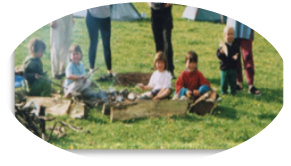The Importance of ‘Free Play’
Some Early Year’s education theorists and psychologists have presented the importance of free play activity as a prerequisite foundation for learning (Einarsdottir&Wagner,2006:208) The work of Macmillan (Bradburn,1976:57-58), Montessori(1967:173), Steiner(1981:51-54)and Goldschmied(Goldschmied&Jackson,2004:97-99) suggest young children are spontaneous observers of nature and can gain a wealth of perceptual skills and detailed awareness of discrimination and differentiation (Montessori,1967:70-71.) long before this information is consciously structured, categorised, calculated or manipulated as an academic understanding through formal thinking operations. The freedom to play and explore the abundance of materials and possible activities given by a natural outdoor environment can encourage and support the unlimited aspects of human potential – ‘physical performance’ related to ‘physical intelligence’, the mastery of integrating thoughts with actions.
‘Essential changes take place in the development of a child’s motivation under the influence of play.’ (Einarsdottir&Wagner,2006:214citingEl’konin (1978/1999))
Play seems to embrace a purity of thought that perceives truth without educational interference and thereby initiates the powers of thought within a cycle of dream-thought- action and the development of talent.
‘…even a small child should not be distracted from what he’s doing in other words the operation of his thought should not be stopped……education …begins with the correct presentation of questions whereby children are encouraged to think for themselves and make their own independent decisions. ’ (Megre Book7;49)
Pioneering educators that advocate the young child’s affinity with the naturalecology, considered the natural environment a stimulating and nurturing resource for all aspects of the young child’s physical, mental, emotional and spiritual development.
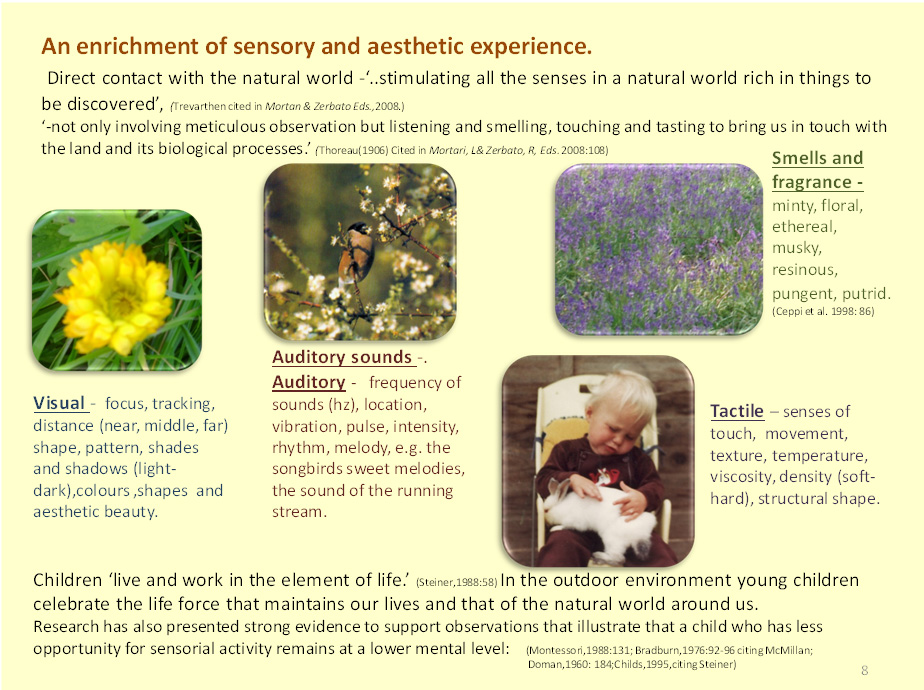
‘A child needs to live naturally and not simply have knowledge of nature.’(Montessori,1967:67,172)(Montessori,1988:200)
In the Norwegian nurseries the ‘children experience wooded areas with rivers and streams every day’(Curruthers cited in Moyles,2007:176)Lasenby describes weather as ‘one of the most valuable resources’ which provides experiential experience that increases children’s ‘knowledge and understanding of the world in which they live.’ (Cited in Ouvry,2003:24)In Finland the outdoor Forest School approach presents the wild natural environment and the changing seasons as the curriculum and the teacher for children up to the age of six; Finland is regularly placed in top positions in the Organisation for Economic Cooperation and Development’s ‘prestigious world rankings for educational performance and literacy’. (Honore, 2004:25)
Forest schools present a belief in ‘the holistic benefit of natural experiences’ and consider the natural environment as ‘awe-inspiring’ for young children. (Moyles,2007:177)The Danish Early Years curriculum describes the Natural outdoor Forest School environments successfully meet the following six areas of learning required ‘to create a competent child’:-
- Language,
- All round Personal development,
- Body and movement,
- Nature and natural phenomena,
- Cultural expression and values,
- Social development. (Austin,2007:64;)
The natural environment is also very favourably towards Montessori’s description of the important Sensitive Periods of learning during young children’s development :-
Language,
Order,
Sensory-motor activity – refinement of the senses,
Walking (postural reflexes),
Small objects,
Spiritual awareness.
(Montessori,1988:201;Montessori,1967:172;Goddard 2004:94&Meadows,2006:336)
‘Research….suggests that children seem to have a special affinity, or connection to the natural world – that they experience a kind of ‘primal seeing’ which allow them to ‘ experience the natural world in a deep and direct manner, not as a background for events, but rather, as a factor and stimulation.’ (Sebba cited in MacMillan,2008:10)
Nature’s curriculum is one of open ended activities with open ended choices and open ended results. This has been seen to give children a sense of independence, personal confidence and enthusiasm to engage in the child’s own perspectives of meaningful play.
Throughout the first eight years of life Movement in space is directly related to balance, sensory integration, confidence and foundations for learning.
Researchhas shown that‘…children who play in the forest tend to demonstrate better motor skills than children who play in a traditional playground.’(Moyles, Ed. 2007:183. Citing Fjortoft&Sagerie ,2000.)
Natural environments usually offer: an infinite range of colours and shapes, temperature, textures, and patterns that relate to visual discernment of growth (construction) and deterioration (destruction); rich diversity of sensory perception in simple formats that encourage appreciation of appearance, contrasts and attention to the intricate details of movement, differences and change offer a wide choice of activity to suit different levels of confidence, adventure and physical ability.

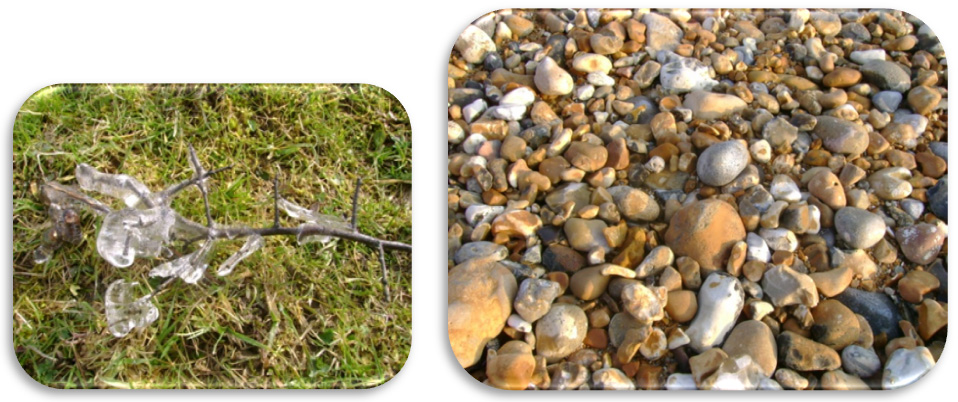

Visual Perceptual Skills
Visual perceptual skills are strongly motivated within the world of nature especially in relation to animals where detailed visual discriminationincludes the skills of visual tracking and visual closure.
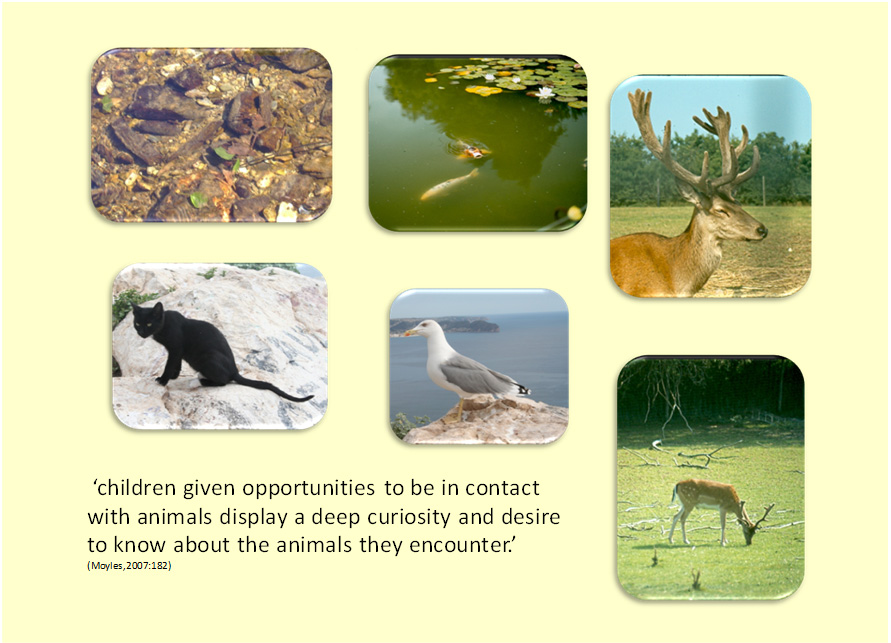
Freedom to Move
Outdoor spaces offer more physical space which supports greater freedoms of physical activity and therefore accidents may be less frequent and less serious than those encountered in the more crowded and intense indoor environments……
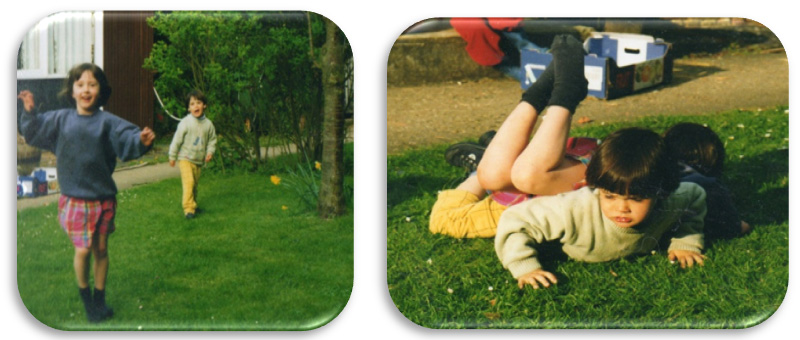
The children learn to take responsibility for their own awareness of what they can do safely. The natural outdoor environment addresses the output and impute of sensory information from all the major sensory modalities and ‘leads to the recognition that the entire brain is involved in movement.’ (Callaway,2005:10)
Issues related to children’s safety are integral to their ability to judge what level of activity can be accommodated safely on a moment by moment basis. The skills associated with safety are also interconnected with other areas of development such as those listed below:-
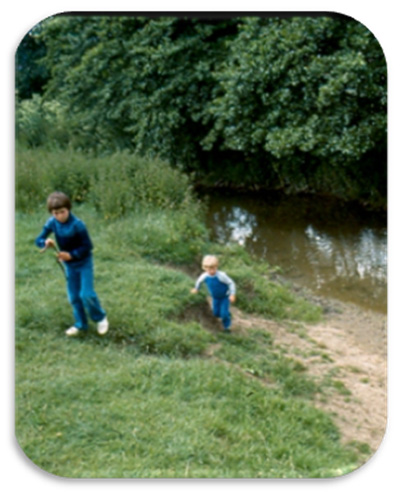
- Secure balance is inseparable from the development of postural control, which in turn is supported by information from: visual, proprioception, and motor systems.’
- Physical movement and the development of visual eye movements and associated visual perceptual competence are interdependent.
- The academic foundations of numeracy, reading and writing are initially dependent upon the ability to know one’s ‘position in space’ and associated directional awareness.
Physical Movement, Balance and Auditory perceptual skills
A growing body of evidence indicates that direct exposure to nature is essential for physical and emotional health. Early creativity and experimentation during free play can provide important foundations for future ‘formal operations’ and skills of creative performance.
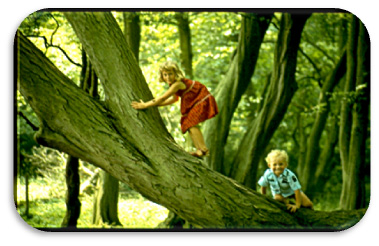
The skills of balance, mobility and co-ordination associated with physical movement have been shown to improve children’s ability to negotiate challenges and explore related aspects of ability and safety.Natural environments can offer a wide choice of activity to suit different levels of confidence, adventure and physical ability.(Callaway,2005:10)
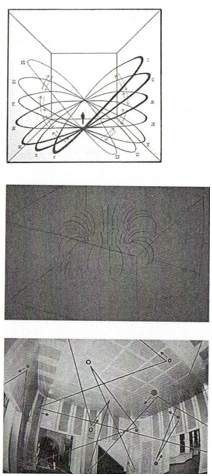 ‘Education cannot be effective unless it helps the child to open himself to life………it is essential that a child’s spontaneous movements should not be checked or that he be compelled to act according to the will of another.’ (Montessori,1967:50)
‘Education cannot be effective unless it helps the child to open himself to life………it is essential that a child’s spontaneous movements should not be checked or that he be compelled to act according to the will of another.’ (Montessori,1967:50)
Vestibular stimulation also influences specific physiological and biochemical changes in the body associated with emotional experiences.
‘Immature vestibular functioning is frequently found amongst children who have specific learning difficulties and adults who suffer from anxiety and Agoraphobia and panic disorders.’ (Goddard,2004:17)
‘Nature deficit disorder …… diminished used of the senses, attentiondifficulties and higher rates of physical and emotional illness.’ New studies suggest that the exposure to nature may reduce the symptoms of attention deficit hyperactivity disorder and that it can improve all children’s cognitive abilities and resistance to negative stresses and depression.’ (Louv,2006:34)
In contrast to the wealth of experiential sensory experiences presented in natural environments some aspects of indoor learning environments are thought to disrupt the child’s sensory development e.g. manmade structures, buildings and machinery are thought to disturb the young child’s developing auditory perception and integration of sounds.
At birth the human ear has the potential to detect frequencies from16hz low sounds up to 25000hzhigh sounds. Low frequencies sounds below 100hz are often felt as vibrations through the skin rather than heard.’ and most adults have lost the range of hearing they were born with only retaining accurate hearing within the range of their spoken language of approximately 125-8000hz. The work of Johansen, using frequency specific music for improving hearing discrimination and speed and integration of auditory processing, has successfully helped children with learning difficulties such as dyslexia. In order to locate the source of sound the brain interprets the small differences in time and intensity between how and when a sound is received in the two ears.
‘Nature finds expression through music- From the whispering of the wind in the leaves, to the thundering of a stormy sea on the shore. Just as all living things share the characteristic of motion, all of life is sound….’(Goddard, 2004:69,73,79,91)
The work of Rauscher & Shaw (1996) showed a clear ‘link between music, and Spatial intelligence – the accurate perceptual ability and mental imagery in pre-school children. (Cited in Goddard,2004:79)
Within any building sounds are distorted by reverberation and absorption as illustrated in these diagrams.
Some buildings also have special insulation to keep out external sounds. Within the indoor classroom background noise and auditory language is likely to dominate the acoustic geography and may deter the children from retaining and developing focused listening skills. These factors also add complex auditory deviations and variables of intensity to the young child’s task of developing accurate auditory perceptual skills and may contribute to why children prefer to play outside where the acoustics are more stable.
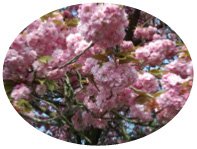 Questions to consider :-
Questions to consider :-
- At what point does auditory sound become ‘obnoxious sensory stimulation…perceived as noise’ ? (Taylor p112 )
- What influence might this have on the young child’s auditory range of perception and development of discrimination?
- What auditory range might we suppose is perceived by children who have grown up in natural outdoor environments, living within nature’s sounds and silences?
(Ceppi,&Zini,1998:90&95)
Also one could consider how strong smells presented in manmade materials may disrupt the young child’s natural range of ability to discern different subtleties of smell. Even when the natural sensory stimulus is very strong, nature appears to present a sense of balance and harmony that calms situations of potential frustration, fear or overwhelming stimulus with complementary contrast, a sense of predictability and natural elements of geographic control: gravity, density, force .

A growing body of evidence indicates that direct exposure to nature is essential for physical and emotional health. ‘Nature deficit disorder …… diminished used of the senses, of attention difficulties and higher rates of physical and emotional illness.’
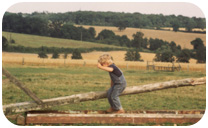 New studies suggest that the exposure to nature may reduce the symptoms of attention deficit hyperactivity disorder and that it can improve all children’s cognitive abilities and resistance to negative stresses and depression.’ (Louv,2006:34)
New studies suggest that the exposure to nature may reduce the symptoms of attention deficit hyperactivity disorder and that it can improve all children’s cognitive abilities and resistance to negative stresses and depression.’ (Louv,2006:34)
‘Presently the Early Years Foundation Stage (DfES 2006) is promoting and focusing on teachers’ awareness of engaging boys. More access and opportunity to go outside and connect with larger spaces that can accommodate boys’ interests’ and ‘provide a more boy-friendly environment.’(Moyles, Ed. 2007:182) 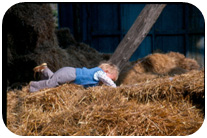
The natural world bountifully nurtures all aspects of movement and sensory experience within an essentially social and spiritual constitution that gives a depth and wealth of support to early development within the sensitive periods. (Montessori,1988:201; Montessori,1967:172; Meadows,2006:336)
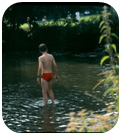 The pictures below illustrate an example of the different sensory experience and interaction presented to a child’s feet within the contrasting indoor and outdoor play experiences.
The pictures below illustrate an example of the different sensory experience and interaction presented to a child’s feet within the contrasting indoor and outdoor play experiences.
(Myriad; Catalogue 12, 2009: 11, 68, 15&22 )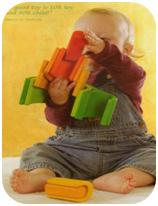
The natural elements of the outdoor environment can take wellbeing beyond that of thinking, feeling and doing to one of appreciation, gratitude, celebration and loving care. Thus, the seeds of intellectual and spiritual enquiry are sewn together with perceptual depths and physical ability; a holistic approach to learning. This builds cognitive intellectual development and initiates aesthetic and inventive application to creative activity – whereby, a state of wellbeing and joyful happiness can be maintained.
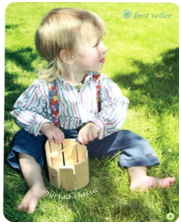 ‘Research….suggests that children seem to have a special affinity, or connection to the natural world – that they experience a kind of ‘primal seeing’ which allow them to ‘ experience the natural world in a deep and direct manner, not as a background for events, but rather, as a factor and stimulation.’ (Sebba cited in MacMillan,2008:10)
‘Research….suggests that children seem to have a special affinity, or connection to the natural world – that they experience a kind of ‘primal seeing’ which allow them to ‘ experience the natural world in a deep and direct manner, not as a background for events, but rather, as a factor and stimulation.’ (Sebba cited in MacMillan,2008:10)
‘For everything going on in nature is permeated by a hidden music, the earthly projection of the “music of the spheres.” Every plant, every animal actually incorporates the tones of the music of the spheres.’ (Steiner,1982:19)
In Scandinavia Nature provides the Kindergartens with the educational environment and curriculum of activity, the adults have responsibility for maintaining that the children are well nourished with suitable provisions for rest/sleeping and are appropriately dressed in all weathers. Adults are also available to respond to children’s communications, interests and requests for companionship, supportive scaffolding, and play-partnerships. The adult also has a passively receptive role – quiet, attentive and observant, and generally refrains from actively presenting encouragement, suggestion, praise or directives. If a child is busily engaged s/he is ‘left undisturbed for as long as possible’. During a child’s discovery process the adult does not present any ‘unnecessary talk’, interfere with the child’s concentration or disrupt ‘natural situations for peer scaffolding for learning concrete skills.’ (Einarsdottir&Wagner,2006:208) Harrison, (2002:13)suggests that when children are free to explore they can ‘discover their passions – the activities, the skills that bring forth the totality of their Life Energy’. They can come to ‘understand the nature of a joyful life’ where, success and failure are intrinsic within the creativity of observation and doing; free from contrived external rewards or reprimands, manmade structures, preconceived styles of learning, restrictive boundaries, predetermined social rules and external expectations.
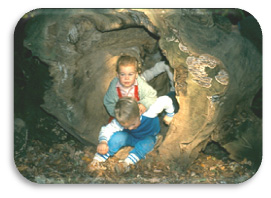 The natural world as curriculum and teacher bountifully nurtures all aspects of movement and sensory experience within an essentially social and spiritual constitution that gives a depth and wealth of support to early development within the sensitive periods. The natural elements of the outdoor environment can take wellbeing beyond that of thinking, feeling and doing to one of appreciation, gratitude, celebration and loving care. Thus, the seeds of spiritual enquiry are sewn together with perceptual depths. This builds cognitive intellectual development and initiates aesthetic and inventive application to creative activity.
The natural world as curriculum and teacher bountifully nurtures all aspects of movement and sensory experience within an essentially social and spiritual constitution that gives a depth and wealth of support to early development within the sensitive periods. The natural elements of the outdoor environment can take wellbeing beyond that of thinking, feeling and doing to one of appreciation, gratitude, celebration and loving care. Thus, the seeds of spiritual enquiry are sewn together with perceptual depths. This builds cognitive intellectual development and initiates aesthetic and inventive application to creative activity.
The natural environment provides a treasure basket of natural materials for heuristic play (Goldschmied, 2004),as well as a wealth of aesthetic experiences. Motivation for movement is related to interest, needs and abilities provided by interactive experiences with natural phenomena which encourage good foundations for physical development, health and fitness.Human biology illustrates that there is a direct relationship between exercise, physical growth, breathing rate, lung capacity, neurological brain development, emotional stability and intellectual development.(Vander et al. 2001)Doman’s research illustrated that functional activity determines structural development in the brain as well as in the body. (Doman,1960:189&262)Steiner presents that Sensory-motor activity (movement) ‘also equates with the consequential development of language and thinking.’ (Steiner, 1988:32)
 ‘… humanity, which is revealed in all its intellectual splendour during the sweet and tender age of childhood ……. is like a sun which appears at dawn or a flower just beginning to bloom. Education cannot be effective unless it helps the child to open himself to life.’ (Montessori,1967:50)
‘… humanity, which is revealed in all its intellectual splendour during the sweet and tender age of childhood ……. is like a sun which appears at dawn or a flower just beginning to bloom. Education cannot be effective unless it helps the child to open himself to life.’ (Montessori,1967:50)
In the outdoor environment young children celebrate the life force that maintains our lives and that of the natural world around us. When we the educators have the privilege of observing how, children celebrate their love of life in natural outdoor environments and dance in a joyful mood or, on occasions in a festive way that lasts for two or three consecutive days; then we are honoured with a spiritual initiation that can bring us to share the children’s effulgent state of being and know a potential beyond that of happiness and enthusiasm – when the God we seek is found within our state of wellbeing and joyful inner harmony.
When in a natural outdoor environment spiritual aspirations are initiated by natural phenomena. For example the author recalls a truly unforgettable experience of beauty and stillness, that invoked a quietening of the mind normally associated with contemplation and states of meditation: It happened while on a winter forest walk with a group of young children, along a sheltered track that followed a small valley and stopped at a favourite place by the stream. It was quiet and the children were relaxed and happy to just be there by the stream peacefully. Then a deeper sense of stillness came over the area, like an invisible blanket it created a silence beyond that of the stillness, it felt as if nature herself had stopped breathing. My feelings drifted from a divine kind of inner peace into occasional momentary feelings of protective concern. Before I could decide upon any leadership action the snow clouds could be seen creeping towards us bringing a snowflake waterfall that appeared advancing against the strong flow of the stream, silently it filled the valley with a rapidly growing depth of pure whiteness.
In nature children can find extensive challenges at all levels of relationship and personal ability that gently encourage them to go a little further than before…..If we use the unlimited natural resources of our universe to support children’s development of awareness, and their speed and parameters of thought, then the potential of the future can extend beyond what humanity has attained to date.
In Honour of the Trees
Standing tall in your strength against time.
In silent unseeing observation,
Of generations growing from child into parenting.
While the wind brings an ever moving creativity to your serenity,
Your roots remain secure in the abundance of a future potency,
You greet the ways of our days
But we rarely appreciate the longevity of your life giving presence.
Those unconditional fortunes given to a world of little gratitude and faint observations.
What have you seen that we still don’t understand?
What have we done to the natural lands?
Yet still the sun, the moon and the stars
Shine their blessings upon thee
As your leaves float on down the stream
Winter flows under your boughs once again.
As my life weakens with old age
Yours grows with everlasting maturity
Our reunion builds a rainbow across my lifetime,
As again I feel your companionship to my childhood.
‘Free Play’as a Foundation for Learning
Some Early Year’s education theorists and psychologists have presented the importance of free play activity as a prerequisite foundation for learning (Einarsdottir&Wagner,2006:208) The work of Macmillan (Bradburn,1976:57-58), Montessori(1967:173), Steiner(1981:51-54)and Goldschmied(Goldschmied&Jackson,2004:97-99) suggest young children are spontaneous observers of nature and can gain a wealth of perceptual skills and detailed awareness of discrimination and differentiation (Montessori,1967:70-71.) long before this information is consciously structured, categorised, calculated or manipulated as an academic understanding through formal thinking operations. The freedom to play and explore the abundance of materials and possible activities given by a natural outdoor environment can encourage and support the unlimited aspects of human potential – ‘physical performance’ related to ‘physical intelligence’, the mastery of integrating thoughts with actions.
‘Essential changes take place in the development of a child’s motivation under the influence of play.’ (Einarsdottir&Wagner,2006:214citingEl’konin (1978/1999))
Play seems to embrace a purity of thought that perceives truth without educational interference and thereby initiates the powers of thought within a cycle of dream-thought- action and the development of talent.
‘…even a small child should not be distracted from what he’s doing in other words the operation of his thought should not be stopped……education …begins with the correct presentation of questions whereby children are encouraged to think for themselves and make their own independent decisions. ’ (Megre Book7;49)
Pioneering educators that advocate the young child’s affinity with the naturalecology, considered the natural environment a stimulating and nurturing resource for all aspects of the young child’s physical, mental, emotional and spiritual development.
Exploration and Discovery Learning
‘Children if left to explore can discover their passions – the activities, the skills that bring forth the totality of their Life Energy’. They can come to ‘understand the nature of a joyful life’ where, success and failure are intrinsic within the creativity of observation and doing; free from man-made rewards and punishment, structural boundaries and associated dangers, social rules and expectations. (Harrison,2002:13) In nature children are finding out about the world for themselves, and about themselves as a part of the living world.
Research has suggested that adults are more willing to let children:-
- direct their own play activities,
- organise and change the physical aspects of the environment,
- integrate themselves socially into their own co-operative games,
- settle their own disputes and issues of conflict, and children are more able to:-
- request help from adults and peers,
- play cooperatively together in mixed age groups,
- play cooperatively with children from different backgrounds and/or learning disabilities.
 Children can make choices of what, when and how to share with adults and vice versa.
Children can make choices of what, when and how to share with adults and vice versa.
Adults can relax into a more compassionate and attentive role as listener and share in child initiated conversations and activities.
Early creativity and experimentation can provide foundations for future ‘formal operations’ and skills of creative performance
Early creativity and experimentation can provide foundations for future ‘formal operations’ and skills of creative performance
Children enjoy the challenges of working outside with the adults especially when it involves caring for animals, use of tools and physical challenges.
animals, use of tools and physical challenges.
Children enjoy time to do their own thing in their own way, un-witnessedfree from distractions and other’s influences.
 ‘Respectful close observation and passive participation can be effective ways of hearing young children’s powerful communications and taking account of their perspectives…’ (Peter Elfer (2005) Cited in Moyles, 2007:189.) From this perspective adults can successfully scaffold learning with careful adult organisation, specialist supervision and safety equipment.
‘Respectful close observation and passive participation can be effective ways of hearing young children’s powerful communications and taking account of their perspectives…’ (Peter Elfer (2005) Cited in Moyles, 2007:189.) From this perspective adults can successfully scaffold learning with careful adult organisation, specialist supervision and safety equipment.
Adults can structure special activities to suit individual children’s interests and encourage working together and sharing social events as a community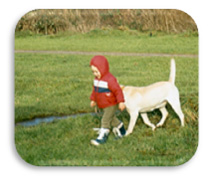
During their early years children may gain an affinity, detailed perceptual skills, and a respectful sense of curiosity and enquiry that can have a positive influence upon their growing intellectual abilities. Steinerdescribes the young child’s affinity to the nature world as ‘a deep, 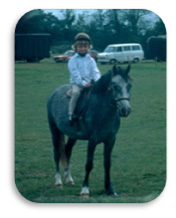 inner feeling that the plant world belongs to the Earth’ and an inner awareness of ‘the true relationship between the human and the animal world…’(Steiner,1997:68) In nature we see skills and abilities that are equal to and beyond normal human abilities.
inner feeling that the plant world belongs to the Earth’ and an inner awareness of ‘the true relationship between the human and the animal world…’(Steiner,1997:68) In nature we see skills and abilities that are equal to and beyond normal human abilities.
